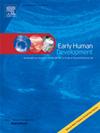Does early prenatal hormonal exposure mediated by social conditioning diminish sex difference in digit ratio (2D:4D) among the elite handball players in Poland?
IF 2
3区 医学
Q2 OBSTETRICS & GYNECOLOGY
引用次数: 0
Abstract
Background
Studies linked differential exposure to prenatal androgens with varied performance in various sports. The ratio of the second-to-fourth digit lengths (2D:4D) is a putative proxy indicator prenatal testosterone exposure – lower 2D:4D indicating higher exposure and vice versa. Previous studies consistently showed negative associations between digit ratio and several sports performances.
Aim
The aim of the present study was to assess if 2D:4D was associated with playing at a higher levels among the Polish male and female handball players and the heterogeneity in sex difference among different levels of handball players compared to a non-player control group.
Method
This cross-sectional study compared 2D:4D between a group of male and female handball players in Polish leagues and a non-player control group (54 males and 34 females). The first group had two categories: Super League (18 males and 17 females) and lower league (47 males and 17 females) players. Height, weight and lengths of 2D and 4D were measured.
Results
Significant sex difference was observed in right hand 2D:4D in the control group. However, no significant sex difference in 2D:4D, for either left or the right hand, was observed among the two handball playing groups. In general, the female players had significantly lower 2D:4D than the non-player controls. However, allowing for age and body size, this sex difference diminished.
Conclusion
Lower 2D:4D was associated with higher level of sports and the elite handball playing females had “masculine” 2D:4D similar to their male counterparts. The results indicated towards a plausible selection in favour of masculinised digit ratio (higher prenatal testosterone exposure) among females in highly competitive professional sports.
由社会条件调节的早期产前激素暴露是否会减少波兰优秀手球运动员手指比例的性别差异(2D:4D) ?
研究表明产前雄性激素的不同暴露与各种运动的不同表现有关。第二个和第四个手指的长度之比(2D:4D)被认为是产前睾酮暴露的代理指标——2D:4D越低表明暴露越高,反之亦然。先前的研究一致表明,手指比例与一些运动成绩之间存在负相关。目的本研究的目的是评估波兰男女手球运动员的2D:4D是否与较高水平的手球比赛有关,以及与非手球运动员对照组相比,不同水平手球运动员之间性别差异的异质性。方法横断面研究比较波兰联赛男女手球运动员和非球员对照组(男性54名,女性34名)的2D:4D。第一组有两个类别:超级联赛(18名男性和17名女性)和低级联赛(47名男性和17名女性)球员。测量二维和四维的身高、体重和长度。结果对照组右手2D:4D有显著性差异。然而,在两个手球组中,左手和右手的2D:4D没有明显的性别差异。一般来说,女性玩家的2D:4D明显低于非玩家控制组。然而,考虑到年龄和体型,这种性别差异减弱了。结论2D:4D值越低,运动水平越高,优秀手球运动员的2D:4D值与男性相似,具有“男性化”特征。结果表明,在竞争激烈的职业运动中,女性的手指比例倾向于男性化(产前睾酮水平较高)。
本文章由计算机程序翻译,如有差异,请以英文原文为准。
求助全文
约1分钟内获得全文
求助全文
来源期刊

Early human development
医学-妇产科学
CiteScore
4.40
自引率
4.00%
发文量
100
审稿时长
46 days
期刊介绍:
Established as an authoritative, highly cited voice on early human development, Early Human Development provides a unique opportunity for researchers and clinicians to bridge the communication gap between disciplines. Creating a forum for the productive exchange of ideas concerning early human growth and development, the journal publishes original research and clinical papers with particular emphasis on the continuum between fetal life and the perinatal period; aspects of postnatal growth influenced by early events; and the safeguarding of the quality of human survival.
The first comprehensive and interdisciplinary journal in this area of growing importance, Early Human Development offers pertinent contributions to the following subject areas:
Fetology; perinatology; pediatrics; growth and development; obstetrics; reproduction and fertility; epidemiology; behavioural sciences; nutrition and metabolism; teratology; neurology; brain biology; developmental psychology and screening.
 求助内容:
求助内容: 应助结果提醒方式:
应助结果提醒方式:


